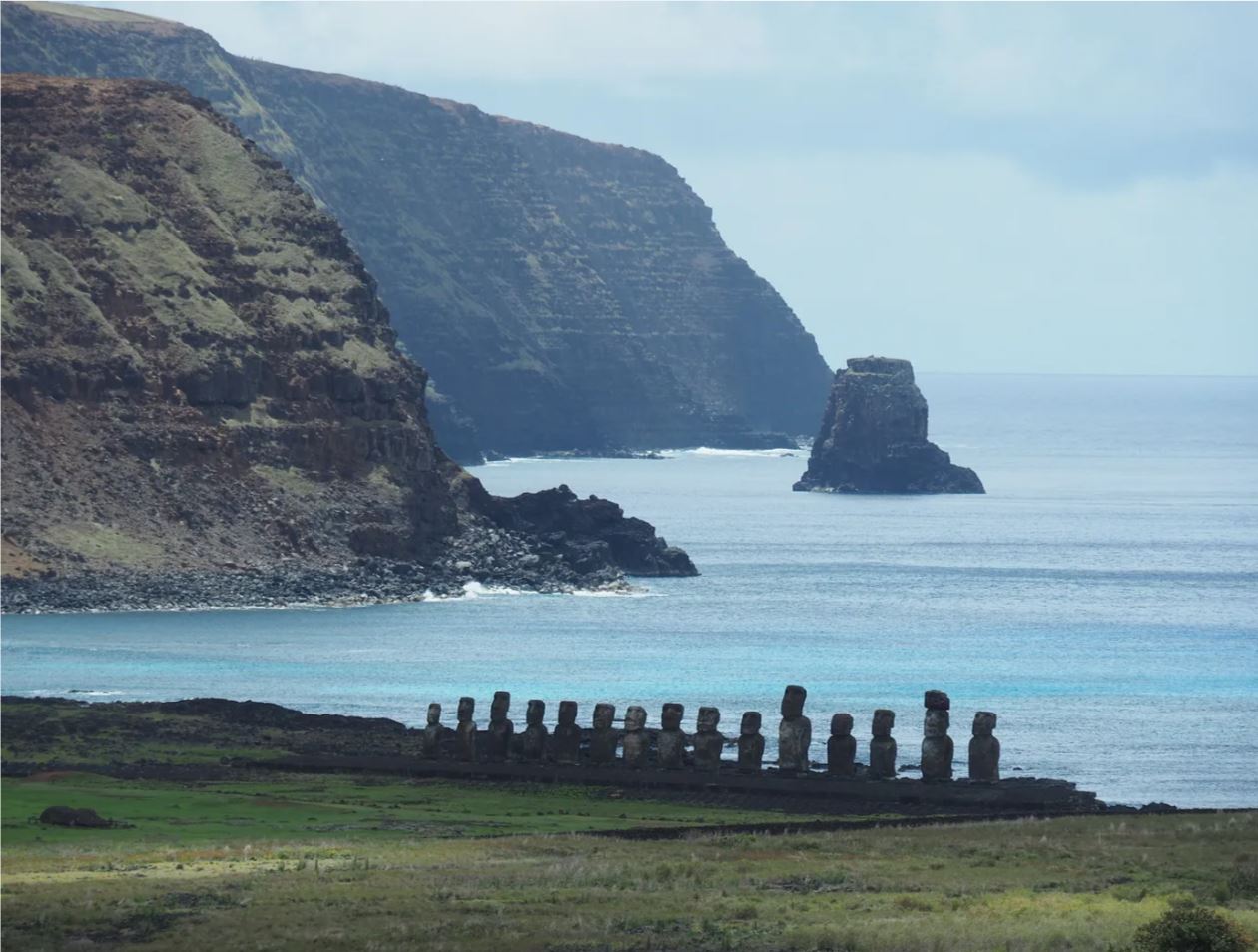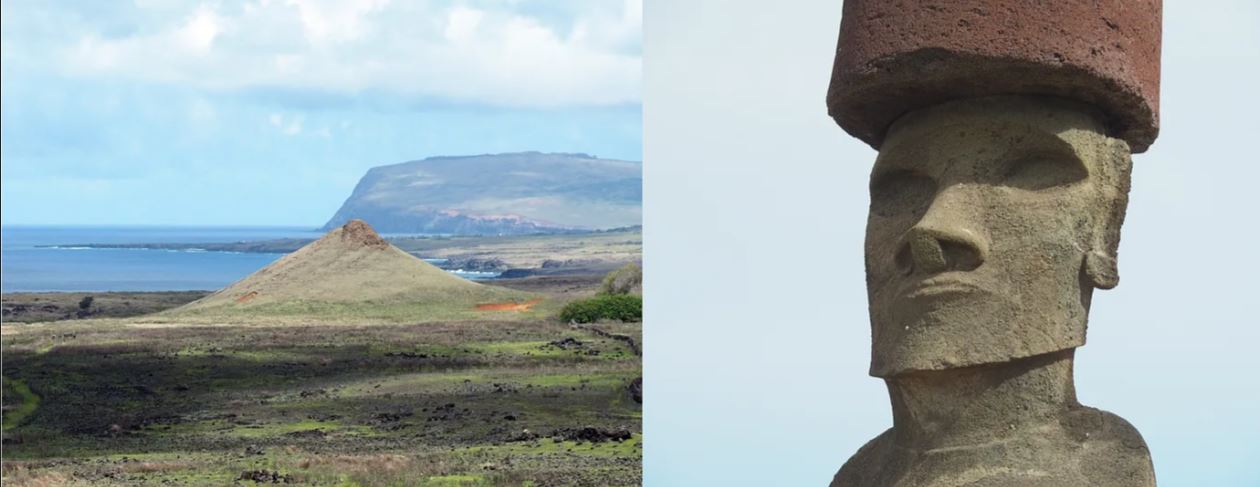
Written By:
David Trubridge
Rapa Nui, Land and Art.

We are all a product of history.
We are who we are, thanks to our ancestors.
Humanity has been created by people, by humanity.
Part of who we are today owes a debt to the Rapa Nui.
A people once lived by and on the ocean. At ease with its mood and changes, which they knew like their lover, they freely roamed the vast watery emptiness. They were always keenly aware of their position under the rising and falling stars, who were their guides.
And so, sailing in the star compass house of Marangai Ra, they came to what they called Rapa Nui. They also continued on to a much bigger land further east, but here they found other people. The sailors were adventurers, not conquerors, so they exchanged some chickens for some sweet potatoes and returned to the small remote island. They also took back with them a new skill: stonework.
Somehow the urge to chase the horizon soon left them and they settled into life in the most isolated human community on Earth. They put their new stone skills to work, building ceremonial community spaces for their villages. They had brought with them from Tahiti a very stratified society with royalty, nobles and workers, so in time they honoured people of māna with statues. These were important ancestors who remained to look after the community, standing tall and proud, with their backs to the sea which they had now forsaken.
Who was the visionary who first conceived of these powerful human megaliths? No one person: as in all cultures, art evolves. But because the Polynesians are an innately conservative society, they soon established a particularly set form of representation. It was not acceptable to step out of line and create something different — originality was anathema. To conform with the community, which protected and nurtured them, was their guarantee of survival.

The towering figures emphasise the head which is the most tapu part of the body, especially that of the ariki. The hands are insignificant because the ariki do not work. Artists are subliminally programmed in their feel for line and form by their surrounding landscape. So the lines of the brow and chin are clean and precisely edged, just like the grassy landscape which sweeps up to the sharply etched ridge of a crater. The eyes gaze out, aloof, like high born, like the volcano summits (originally the sockets had white shells inserted).
So the art was an incremental product of society and land. The stylisation had its own life and justification, its own internal imperative. The only thing that changed over time was their technical mastery over stone: the moai became larger and larger in ever grander statements of self-importance. The giant figures were transported unbelievable distances across the island from one quarry, while the red topknots came from another quarry at the other end of the island. The carving was done by teams, working together in time to a rhythmic chant, chipping at the soft volcanic tuff with harder rocks.
But this obsession started to come at a price: more and more was expected of the land and of the workers. When the very finite and limited island resources were depleted and worker resentment grew, the price became too much. The statues honoured only the nobles, not those who laboured to make and transport them. A tipping point was passed and the workers slaughtered the nobles and toppled the statues. Those who create have the right to destroy.
The people who had gazed out in wonder at the allure of the horizon, had finally turned around and gazed in on themselves. At first they had put their prodigious inventiveness to work with stone, with unbelievable achievement. But ultimately this became their downfall as inward ambition and social competition frittered away their mandate, and the land dried up.
What price great art? Is it still great if it is megalomanic, if it is purely for self-aggrandisement? Should we marvel at the art, or should we wring our hands at the wasted slaves, at the bodies crushed under fallen rock? Does art transcend the conditions of its creation, or is it lessened by them? Should we marvel at the Pyramids’ gigantic perfection, or should we be dismayed at the power of kings who could command such human resources?
I cannot look at the serenity of the moai and not also see a little smugness and self-righteousness. Am I wrong to throw my cultural values outside of my domain? No, I believe that there are human values that are universal and our achievements must always be balanced against the cost. Today the cost of our actions is an increasingly insistent beating at the door of our complacency.
Just as I will not accept a religious practice that requires the sacrifice of animals to facilitate earthly desire, so I will not accept art that requires subjugation of people. So the fallen, broken, face-planted statues represent a necessary rebalancing of past wrongs. I long to see the time when today’s disenfranchised have risen up against the super rich and powerful who are also made to lie face down in the dirt. Ozymandias! “Half sunk, a shattered visage lies.”
But all societies cannot exist without a structure. So the ariki were replaced by the birdmen. There were still chiefs and priests but the ultimate ruler was now chosen, not by ancestry, but by prowess over nature. The restless energy that had driven them to sail the ocean and set up the rows of enormous moai, now became directed at scaling impossible cliffs and swimming wild channels. This cult was open to all, and the island chief for the year was the first to overcome these dangers and return from the outlying rocky islet with an egg. But the victor did not get to lord it over his peers. Instead he became the ultimate in tapu, living alone and isolated in a special hut for the year, until a new birdman was found. Now the chief is more like a yogi, given time to reflect and meditate on his achievement and status — after the triumph of the body, the test of the mind.
Then came the missionaries and more division from a new imposed order. War broke out and the priests herded the people into one town for “safety”. Many were transported to Moorea where the missionaries bought land for them. Many were blackbirded to Peru to work the guano. Eventually the resources that the island could no longer provide were brought by ship from Chile, the new colonial master . . . along with tourists.
The missionaries devalued their traditions and subverted their natural spirituality. This paved the way for collectors to come and pillage the rich history and artefacts. Thor Heyerdahl writes with pride about how he tricked the “superstitious” natives into renouncing their traditional beliefs. They would then reveal to him their secret caves and the precious contents, which were now no longer protected by their ancestral spirits. He sailed off, like many others, with a boatload of plunder which is now in museums across Europe and the Americas.
It could be argued that these priceless works were being kept safe in museums from other more ruthless collectors, such as the US Navy which destroyed birdman houses to carry off carvings and drawings for the officers. But those times have passed and we live in an era with far more respect for indigenous peoples and their cultures. Those artefacts only really come alive in their rightful home, in the land and the culture that created them. In distant museums they lose all māna and relevance. There is no justification today for keeping them locked away, mostly unseen. It is outrageous that only replica tablets of the unique and undeciphered rongorongo script, can be seen on the island. Artefacts can speak in a unique voice of the land of their birth, just like language.
Some say that these artworks are like ambassadors for their culture, enlightening those in far off lands. But they also said that of captive orcas . . . who died wasted and demoralised. The replicas should be in the museums telling their stories, and the originals repatriated to live on, cared for in their rightful homes.

Jared Diamond, in his book ‘Collapse’, famously used the Rapa Nui story to show how human societies can fail by destroying their environment. But there is more to the story than this. Their art remains, whether you love it, or are disturbed by it, or probably both. It has become part of the greater human culture, affecting us all, changing us all in some subtle way, as all great art does. I am thinking now, not of the moai, but of smaller and unique wood carvings, such as the figure I saw in the Santiago Museum of Pre-Columbian Art. Its shoulders are rounded and resigned, its ribs sharply defined as if emaciated, and its face is a distraught grimace of pain. Who created this and out of what trauma? This, for me, is a far more profound creation than the megaliths, which are more likely just to inspire awe. It is art like Picasso’s Guernica which must be spoken, must be seen and must be heard if we are to continue to better ourselves and our culture.